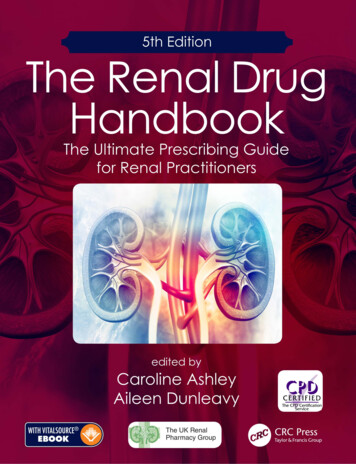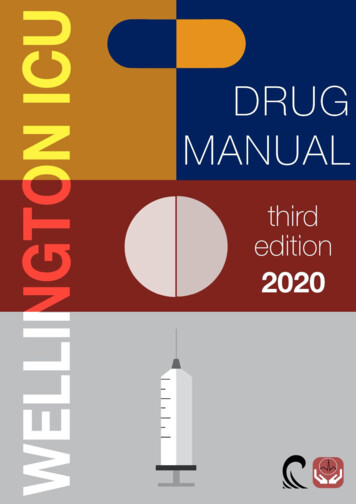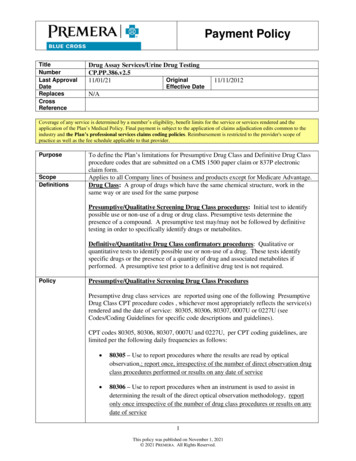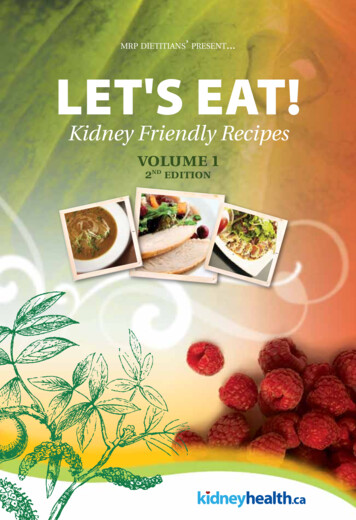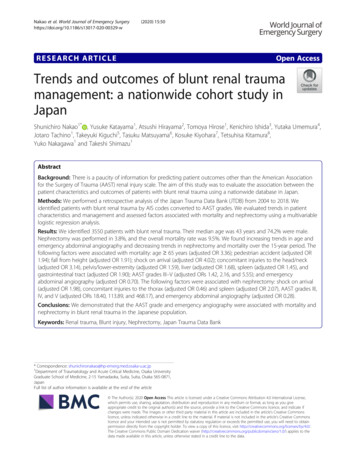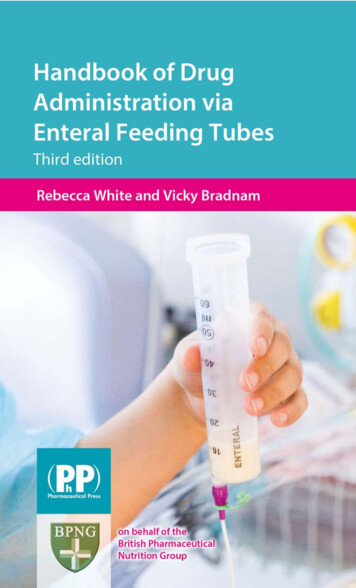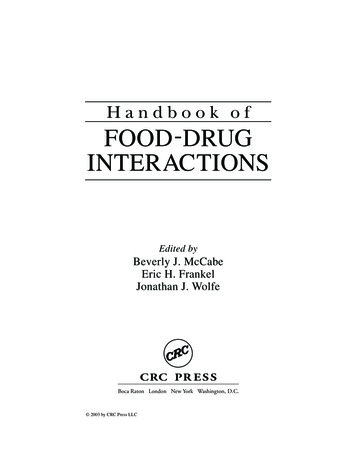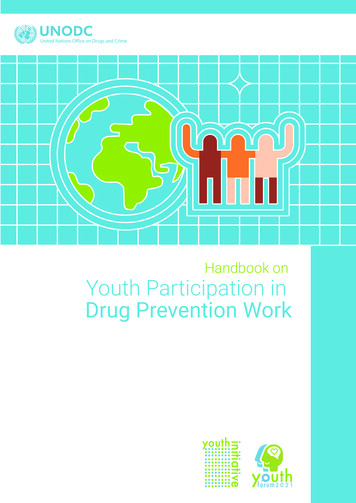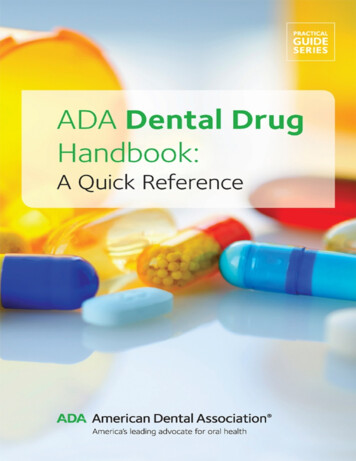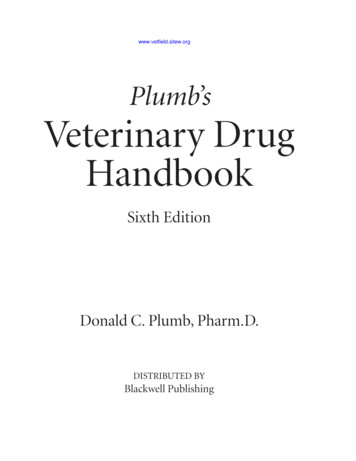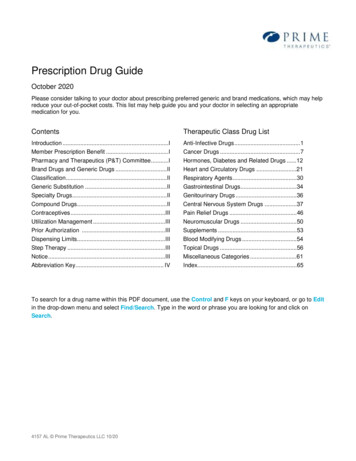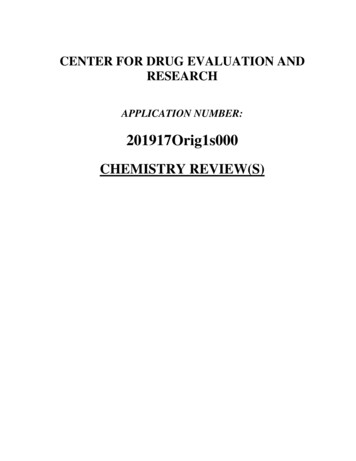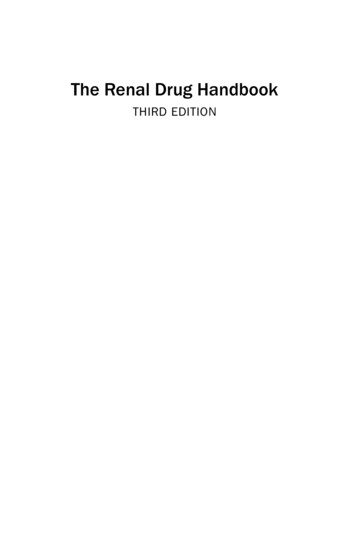
Transcription
The Renal Drug HandbookThird Edition
The Renal Drug HandbookThird EditionEdited byCaroline Ashley and Aileen CurrieUK Renal Pharmacy GroupForeword byDr Aine BurnsRadcliffe PublishingOxford New York
Radcliffe Publishing Ltd18 Marcham RoadAbingdonOxon OX14 1AAUnited Kingdomwww.radcliffe-oxford.comElectronic catalogue and worldwide online ordering facility. 2009 Caroline Ashley and Aileen CurrieFirst Edition 1999Second Edition 2004Caroline Ashley and Aileen Currie have asserted their right under the Copyright,Designs and Patents Act 1998 to be identified as the authors of this work.All rights reserved. No part of this publication may be reproduced, stored in aretrieval system or transmitted, in any form or by any means, electronic, mechanical,photocopying, recording or otherwise, without the prior permission of the copyrightowner.Every effort has been made to ensure the accuracy of these guidelines, and that thebest information available has been used. This does not diminish the requirement toexercise clinical judgement, and neither the publishers nor the original authors canaccept any responsibility for their use in practice.British Library Cataloguing in Publication DataA catalogue record for this book is available from the British Library.ISBN-13: 978 184619 298 2Typeset by Pindar NZ, Auckland, New ZealandPrinted and bound by TJI Digital, Padstow, Cornwall, UK
ContentsForewordPrefaceAbout the editorsList of abbreviationsAbacavirAbataceptAbciximabAcamprosate calciumAcarboseAcebutololAceclofenacAcenocoumarol (nicoumalone)AcetazolamideAcetylcysteineAciclovir IVAciclovir oralAcipimoxAcitretinAcrivastineAdefovir dipivoxilAdenosineAdrenaline (epinephrine)Albendazole (unlicensed product)Alemtuzumab (MabCampath)Alendronic acidAlfacalcidolAlfentanilAlimemazine tartrate (trimeprazine)Aliskiren fumarateAllopurinolAlmotriptanAlteplase (rt-PA) (recombinant humantissue-type plasminogen activator)Aluminium hydroxideAmantadine hydrochlorideAmikacinAmiloride hydrochlorideAminophyllineAmiodarone hydrochlorideAmisulprideAmitriptyline neAmoxicillinAmphotericin IV – Abelcet (lipid complex)Amphotericin IV – Ambisome (liposomal)Amphotericin IV – Amphocil (complexwith sodium cholesteryl sulphate)Amphotericin IV – astrozoleAnidulafunginApomorphine ic trioxideArtemether with lumefantrineAscorbic acidAspirinAtazanavirAtenololATG (Rabbit) (Thymoglobuline)AtorvastatinAtovaquoneAtracurium 44454647BaclofenBalsalazide sodiumBasiliximabBemiparin sodium 8596061626364656667697072737475767778
viContentsBenzatropine mesilate (benztropine)Benzbromarone (unlicensed product)BenzylpenicillinBetahistine dihydrochlorideBetamethasoneBetaxolol acodylBisoprolol n hydrochloride(amfebutamone HCl)Buspirone 899100101102CabergolineCalcitonin (salmon)/salcatoninCalcitriolCalcium acetateCalcium carbonateCalcium gluconateCalcium ResoniumCandesartan 105CeftazidimeCeftriaxoneCefuroxime (oral)Cefuroxime (parenteral)CelecoxibCeliprolol hydrochlorideCetirizine hydrochlorideCetuximabChloral hydrateChlorambucilChloramphenicolChlordiazepoxide hydrochlorideChloroquineChlorphenamine maleate(chlorpheniramine)Chlorpromazine hydrochlorideChlorpropamideChlortalidone mycinClindamycinClobazamClofazimineClomethiazole (chlormethiazole)Clomipramine hydrochlorideClonazepamClonidine hydrochlorideClopidogrelClozapineCo-amoxiclav (amoxicillin/clavulanic acid)Co-beneldopa (Madopar)Co-careldopa (Sinemet)Co-codamol (paracetamol and codeinephosphate)Codeine phosphateCo-dydramol (paracetamol 183
ContentsColchicineColestipol hydrochlorideColestyramine (cholestyramine)ColistinCortisone acetateCo-trimoxazole (trimethoprim sphamideCycloserineCyproterone acetateCytarabineCytomegalovirus (CMV) humanimmunoglobulin zumabDactinomycinDalteparin sodium (LMWH)Danaparoid sodiumDapsoneDaptomycinDarbepoetin asiroxDeferiproneDeflazacortDemeclocycline hydrochlorideDesferrioxamine mesilateDesirudin (unlicensed product)DesloratadineDesmopressin rphine hydrochlorideDiazepamDiazoxideDiclofenac sodiumDidanosineDigitoxinDigoxinDihydrocodeine 4190192193194195196197199viiDiltiazem hydrochlorideDipyridamoleDisodium etidronateDisodium elDolasetron mesilateDomperidoneDonepezil hydrochlorideDopamine hydrochlorideDopexamine hydrochlorideDornase alfaDosulepin hydrochloride (dothiepin)Doxapram hydrochlorideDoxazosinDoxorubicin hydrochlorideDoxycyclineDrotrecogin riptanEmtricitabineEnalapril maleateEnfuvirtideEnoxaparin sodium (LMWH)EntecavirEpirubicin hydrochlorideEplerenoneEpoetin alfa (Eprex)Epoetin beta (Neorecormon)Epoprostenol enemErythromycinEscitalopramEsmolol hydrochlorideEsomeprazoleEstramustine phosphateEtamsylateEthambutol 83284285286
viiiContentsEtomidateEtoposideEtoricoxibEverolimus (unlicensed anylFerrous gluconateFerrous sulphateFexofenadine hydrochlorideFilgrastimFinasterideFlecainide bine phosphateFludrocortisone amine maleateFolic acidFolinic acid (calcium folinate)Fondaparinux sodiumFormoterol fumarate (eformoterol)FosamprenavirFoscarnet sodiumFosinopril sodiumFosphenytoin sodiumFrovatriptanFulvestrantFurosemide nclamideGliclazideGlimepirideGlipizideGlyceryl trinitrateGranisetronGriseofulvinGuanethidine eridolHeparinHydralazine hydrochlorideHydrocortisone acetateHydrocortisone sodium succinateHydromorphone hydrochlorideHydroxycarbamide (hydroxyurea)Hydroxychloroquine sulphateHydroxyzine hydrochlorideHyoscine butylbromideHyoscine ronic acid366Ibuprofen368Idarubicin 4Imidapril hydrochloride375Imipramine in381Indoramin383Inositol nicotinate384Insulin – soluble (Actrapid or Humulin S) 385Interferon alfa-2a (Roferon-A)386Interferon alfa-2b387Interferon beta389Interferon gamma-1b (Immukin)390Ipratropium bromide391Irbesartan392Irinotecan hydrochloride393Iron dextran 5% solution394Iron sucrose395Isoniazid396
ContentsIsosorbide dinitrateIsosorbide mononitrateIsotretinoinIspaghula huskIsradipineItraconazoleIvabradine zoleKetoprofenKetorolac trometamolKlean-Prep405406408410412Labetalol ineLansoprazoleLanthanum inLercanidipine hydrochlorideLetrozoleLeuprorelin acetateLevamisole (unlicensed product)LevetiracetamLevocetirizine hydrochlorideLevofloxacinLevomepromazine (methotrimeprazine)Levothyroxine sodium (thyroxine)Lidocaine hydrochlorideLinezolidLiothyronine sodium (tri-iodothyronine)LisinoprilLithium carbonateLofepramineLomustineLoperamide pamLosartan ne acetateMefenamic acidMefloquineMeloxicamMelphalanMepacrine hydrochloride emMesalazineMesnaMetformin hydrochlorideMethadone hydrochlorideMethenamine etoclopramide hydrochlorideMetolazoneMetoprolol tartrateMetronidazoleMexiletine hydrochlorideMiconazoleMidazolamMidodrine hydrochloride izolastineMoclobemideModafinilMoexipril hydrochlorideMontelukastMorphineMovicol (active ingredient is theosmotic laxative polyethyleneglycol)MoxifloxacinMoxisylyte 7498499
xContentsMuromonab-CD3 (OKT3) dololNaftidrofuryl oxalateNalidixic acidNaloxone olNefopam hydrochlorideNelfinavirNeomycin sulphateNeostigmineNetilmicinNevirapineNicardipine hydrochlorideNicorandilNicotinic furantoinNizatidineNoradrenaline acid tartrate(norepinephrine bitartrate)NorfloxacinNormal human 5526527OctreotideOestrogen, conjugated (unlicensedproduct)OfloxacinOlanzapineOlmesartan medoxomilOlsalazine nadrine azepineOxprenolol hydrochlorideOxybutynin hydrochlorideOxycodone nium ParicalcitolParoxetinePegfilgrastimPeginterferon alfaPemetrexedPenicillaminePentamidine isetionatePentostatinPentoxifylline (oxpentifylline)Perindopril erbuminePethidine hydrochloridePhenelzinePhenindionePhenobarbital (phenobarbitone)Phenoxymethylpenicillin (penicillin V)Phentolamine mesilatePhenytoinPhosphate supplementsPhytomenadione (vitamin PiroxicamPivmecillinam hydrochloridePizotifenPosaconazolePotassium chloridePramipexolePravastatin 88589590591592593595596597
ContentsPraziquantel (unlicensed product)PrazosinPrednisolonePregabalinPrimaquine phosphatePrimaxin (imipenem/cilastatin)PrimidoneProcainamide ine hydrochlorideProguanil hydrochloridePromazine hydrochloridePromethazine hydrochloridePropafenone hydrochloridePropiverine hydrochloridePropofolPropranolol hydrochloridePropylthiouracilProtamine sulphatePseudoephedrine hydrochloridePyrazinamide (unlicensed product)Pyridostigmine bromidePyridoxine Rabeprazole sodiumRaloxifene plaseRibavirin te RizatriptanRocuronium ennaSertindoleSertralineSevelamer (Renagel )Sibutramine hydrochlorideSildenafilSimple linctusSimvastatinSirolimusSitagliptinSodium bicarbonateSodium chlorideSodium clodronateSodium fusidateSodium nitroprussideSodium valproateSorafenibSotalol treptomycin (unlicensed product)Strontium ranelateSucralfate (aluminium sucrose sulphate)SulfadiazineSulfasalazine atriptanSuxamethonium chlorideSynercid (quinupristin 150 mg/dalfopristin 350 96TacrolimusTadalafil698700697
xiiContentsTamoxifenTamsulosin hydrochlorideTazocin deTenecteplaseTenofovir disoproxilTerazosinTerbinafineTerbutaline llineThiotepaTiagabineTigecyclineTiludronic acidTimentin (ticarcillin/clavulanic acid)Timolol maleateTinidazoleTinzaparin sodium idineTobramycinTolbutamideTolfenamic acidTolterodine madol hydrochlorideTrandolaprilTranexamic acidTrastuzumabTrazodone olic acid757758ValaciclovirValganciclovirValproic nium bromideVenlafaxineVerapamil hydrochlorideVigabatrinVildagliptinVinblastine sulphateVincristine sulphateVindesine sulphateVinorelbineVitamin B and C 8769771772773774775776777778Warfarin ZidovudineZoledronic acidZolmitriptanZolpidem rugs for malaria 92793794
ForewordThis third edition of The Renal Drug Handbook is a fantastic publication. Nephrologyis a complex speciality and, increasingly, specialist nurses and paramedics are involvedin the care of patients. Each of us needs to be wary of prescribing for renal patientsand this handbook provides a highly practical, user-friendly method of ensuringthat appropriate prescriptions are given to patients, whether they have normal renalfunction, renal impairment, transplants or are receiving renal replacement therapy. Inaddition, the authors give very helpful information on pharmacokinetics and commonindications for the use of each drug described. This information is not available inany other single textbook. It is an invaluable resource for all healthcare professionalsbut particularly for those involved in the care of renal patients. A copy of the secondedition can be found chained to note trolleys in all of the wards where renal patientsare cared for in my hospital. This third edition is even more comprehensive.Aine Burns FRCPConsultant NephrologistCentre for NephrologyRoyal Free Hampstead NHS TrustSeptember 2008Return to contents
PrefaceWelcome to the third edition of The Renal Drug Handbook. The information containedin this book has been compiled from a wide range of sources and from the clinicalexperience of the editorial board of the UK Renal Pharmacy Group, all of whom areinvolved in the pharmaceutical care of renally-impaired patients. As such, some of theinformation contained in the monographs may not be in accordance with the licensedindications or use of the drug.The Handbook aims to: provide healthcare professionals with a single reference of easily retrievable,practical information relating to drug use, sourced from the practical experience ofrenal units throughout the UK. By referring to the monographs, the user is guidedin how to prescribe, prepare and administer the drug with due regard to potentiallyserious drug interactions and to any renal replacement therapy the patient may beundergoingprovide a practice-based review of drug utilisation in renal units across the UKindicating, where appropriate, any local methods of use, licensed or otherwise.In recent years, the classification for chronic kidney disease (CKD) has changed,now being described as stages 1–5. Each stage is defined by the patient’s eGFR (orestimated GFR) which is calculated using the MDRD equation (modification of dietin renal disease). One point to note is that the eGFR is normalised to a standard bodysurface area of 1.73 m2. There is relatively good correlation between the two equationsfor calculating renal function in patients of average weight, and either could be usedfor the majority of drugs. However, eGFR should not be used for calculating drugdoses in patients at extremes of body weight nor for drugs with a narrow therapeuticwindow unless it is first corrected to the actual GFR for that patient. Actual GFR canbe calculated from the following equation:Actual GFR (eGFR x BSA/1.73)At extremes of body weight neither the MDRD nor the Cockcroft-Gault equation isparticularly accurate. If an accurate GFR is required, e.g. for some chemotherapy, thenan isotope GFR determination should be performed.The information on dosage adjustments in renal impairment given in this book isbased on Cockcroft-Gault creatinine clearance and not eGFR, since the majority ofpublished information available is based on creatinine clearance.The Handbook is not intended to offer definitive advice or guidance on howdrugs should be used in patients with renal impairment, nor is it a comprehensiveand complete list of all drugs licensed in the UK.Return to contents
Preface xvThe range of drugs covered will continue to grow with subsequent editions. TheHandbook is not a guide to diagnosis nor to a drug’s side-effect profile, except whereadverse drug events are more pronounced in the presence of renal impairment. Formore in-depth information, users are advised to refer to the Summary of ProductCharacteristics, the British National Formulary, package inserts or other productdata.The use of drugs in patients with impaired renal function can give rise to problemsfor several reasons: Altered pharmacokinetics of some drugs, i.e. changes in absorption, tissuedistribution, extent of plasma protein binding, metabolism and excretion. In renalimpairment these parameters are often variable and interrelated in a complexmanner. This may be further complicated if the patient is undergoing renalreplacement therapy.For many drugs, some or even all of the altered pharmacokinetic parameters andmodified interrelationships are unknown. In such circumstances, the informedprofessional judgement of clinicians and pharmacists must be used to predict drugdisposition. This must be based on knowledge of the drug, its class, chemistry andpharmacokinetics in patients with normal renal function.Sensitivity to some drugs is increased, even if elimination is unimpaired.Many side-effects are particularly poorly tolerated by renally impaired patients.Some drugs are ineffective when renal function is reduced.Renal function generally declines with age, and many elderly patients have a GFRless than 50 mL/min which, because of reduced muscle mass, may not be reflectedby an elevated creatinine. Consequently, one can justifiably assume mild renalimpairment when prescribing for the elderly.Many of these problems can be avoided by careful choice and use of drugs. ThisHandbook seeks to assist healthcare professionals in this process.Using the monographs Drug name: The approved (generic) name is usually stated.Clinical use: A brief account of the more common indications in renally impairedpatients is given. Where an indication is unlicensed, this is usually stated.Dose in normal renal function: The doses quoted for patients with normal renalfunction are generally the licensed dosage recommendations stated in the Summaryof Product Characteristics for each drug. Where a product is not licensed in the UK,dosage guidelines are provided by the relevant drug company.Pharmacokinetics: Basic pharmacokinetic data such as molecular weight, halflife, percentage protein-binding, volume of distribution and percentage excretedunchanged in the urine are quoted, to assist in predicting drug handling in bothrenal impairment and renal replacement therapy. ‘–’ denotes ‘not known’ or ‘nodata available’.Dose in renal impairment: The level of renal function below which the dose ofa drug must be reduced depends largely on the extent of renal metabolism andelimination, and on the drug’s toxicity. Most drugs are relatively well tolerated, havea broad therapeutic index or are metabolised and excreted hepatically, so precise
xviPrefacedose modification is unnecessary. In such cases, the user is instructed to ‘dose asin normal renal function’.For renally excreted drugs with a narrow therapeutic index, the total daily maintenancedose may be reduced either by decreasing the dose or by increasing the dosing interval,or sometimes by a combination of both. Dosing guidelines for varying degrees of renalimpairment are stated accordingly. Dose in renal replacement therapy: Details are given for dosing in continuousambulatory peritoneal dialysis (CAPD), intermittent haemodialysis (HD),haemodiafiltration (HDF), continuous venovenous haemodialysis/haemodiafiltration(CVV HD/HDF), and continuous arteriovenous haemodialysis/haemodiafiltration(CAV HD/HDF), where known. Drugs are categorised into dialysable/not dialysable/dialysability unknown, to aid the practitioner in making an informed decisionfor dosing within a particular form of renal replacement therapy. Only a fewspecific guidelines are given for dosing in continuous arteriovenous/venovenoushaemofiltration (CAV/VVH). In general, dosing schedules are the same as thosequoted for CAV/VVHD, although it should be borne in mind that CAV/VVHmay have a lower drug clearance capacity. Thus the clinician or pharmacist shoulduse informed professional judgement, based on knowledge of the drug and itspharmacokinetics, when deciding whether to further modify dosing regimens.It should be noted that HDF removes drugs more efficiently than HD, although thereis limited information in this area.The Intensive Care Group based at St Thomas’ Hospital, London, has an extensivedatabase on drug removal by haemofiltration and haemodiafiltration, so any extrainformation can be obtained from them (Tel. 020 7188 7188, pager 1863 or 1830). Important drug interactions: The interactions listed are those identified by a blackspot in Appendix 1 of the British National Formulary. They are defined as thoseinteractions which are potentially serious, and where combined administrationof the drugs involved should be avoided, or only undertaken with caution andappropriate monitoring. Users of the monographs are referred to Appendix 1 of theBritish National Formulary for a more comprehensive list of interactions deemedto be not so clinically significant.Administration : Information is given on reconstitution, route and rate ofadministration, and other relevant factors. Much of the information relates to localpractice, including information on the minimum volume that drugs can be addedto. Only the most commonly used and compatible reconstitution and dilutionsolutions are stated.Other information: Details given here are only relevant to the use of that particulardrug in patients with impaired renal function or on renal replacement therapy. Formore general information, please refer to the Summary of Product Characteristicsfor that drug.Your contribution to future editions is vital. Any ideas, comments, corrections,
Preface xviirequests, additions, local practices, etc. on the drugs in the Handbook should be putin writing to the Editors-in-Chief: Caroline Ashley, Pharmacy Department, Royal FreeHospital, Hampstead, London NW3 2QG or Aileen Currie, Pharmacy Department,Crosshouse Hospital, Kilmarnock KA2 0BE.Caroline AshleyAileen CurrieSeptember 2008The following texts have been used as reference sources for the compilation of themonographs in this book:Electronic Medicines Compendium.British National Formulary No. 55. London: BMJ Publishing Group/RPS Publishing;2008.Martindale: The Extra Pharmacopoeia. 33rd ed. Pharmaceutical Press; 2002.Bennett WM, et al. Drug Prescribing in Renal Failure: Dosing guidelines for adults. 4thed. American College of Physicians; 1999.Knoben JE, Anderson PO. Clinical Drug Handbook. 7th ed. Drug IntelligencePublications Inc.; 1993.Schrier RW, Gambertoglio JG. Handbook of Drug Therapy in Liver and Kidney Disease.Little, Brown and Co.; 1991.Dollery C. Therapeutic Drugs. 2nd ed. Churchill Livingstone; 1999.Seyffart G. Drug Dosage in Renal Insufficiency. Kluwer Academic Publishers; 1991.Cyclosporin Interaction File (Novartis Pharmaceuticals UK).Drugdex Database. Micromedex Inc., USA.Drug company inescomplete.com
About the editorsCaroline Ashley MSc, BPharm, MRPharmSLead Pharmacist, Renal ServicesRoyal Free Hospital, LondonAileen Currie BSc, MRPharmSSenior Pharmacist, Renal ServicesCrosshouse Hospital, KilmarnockReturn to contents
List of RCLLCMVCNSCOX-2CRFCRIPCSFCSMadvanced breast cancerangiotensin-converting enzymeantidiuretic hormoneacquired immunodeficiencysyndromeantilymphocyte immunoglobulinalanine transaminaseactivated partial thromboplastintimeacute renal failure5-aminosalicylic acidaspartate transaminaseantithymocyte immunoglobulinangiotensin-IIacute tubular necrosisarea under the curveatrioventriculartwice dailyblood pressureBritish Pharmacopoeiabody surface areablood urea nitrogenbody-weightcontinuous ambulatory peritonealdialysiscontinuous arteriovenoushaemofiltrationcontinuous arteriovenoushaemodialysiscentralised intravenous additiveservicechronic kidney diseasecreatinine clearancechronic lymphocytic leukaemiacytomegaloviruscentral nervous systemcyclo-oxygenase-2chronic renal failureconstant-rate infusion pumpcerebrospinal fluidCommittee on Safety of MedicinesCVVHcontinuous venovenoushaemofiltrationCVVHD continuous venovenoushaemodialysisCVVHDF continuous hrome pigmentDICdisseminated intravascularcoagulationDVTdeep-vein thrombosisE/Centeric coatedECGelectrocardiogramECTelectroconvulsive therapyEDerectile dysfunctionEDTAedetic acideGFRestimated glomerular filtration rateERFestablished renal failureESRDend-stage renal diseaseESRFend-stage renal omerular filtration rateGIgastrointestinalGTNglyceryl trinitrateHCLhairy-cell leukaemiaHDintermittent haemodialysisHDFintermittent haemodiafiltrationHITheparin-induced thrombocytopeniaHMG CoA 3-hydroxy-3-methyl-glutarylcoenzyme AHUShaemolytic uraemic syndromeICUintensive care unitIMintramuscularINRinternational normalised ratioIPintraperitonealIVintravenousLFTliver function testLHRHluteinising hormone-releasinghormoneLMWHlow molecular weight heparinReturn to contents
xxList of NYHAOAOCODPAHPCAPCPPCRPDPEPOPRPRCAleft ventricular failuremonoamine oxidasemonoamine oxidase inhibitormyocardial infarctionmycophenolate mofetilmycophenolic acidmodified releasemolecular weightnon-nucleoside reversetranscriptase inhibitornon-steroidal anti-inflammatorydrugnon-small-cell lung cancerNew York Heart Associationosteoarthritisovarian carcinomadailyprimary arterial pulmonaryhypertensionpatient-controlled analgesiaPneumocystis jiroveci pneumoniapolymerase chain reactionperitoneal dialysisParkinson’s diseasepulmonary embolismphenytoin equivalentorallyrectallypure red cell aplasiaprnPTHPTLDwhen requiredparathyroid hormonepost transplant lymphoproliferativedisorderPVCpolyvinyl chlorideRArheumatoid arthritisRBCred blood cellsRhG-CSF recombinant human granulocytecolony-stimulating factorRHuEPO recombinant human erythropoietinSBECD sulphobutylether beta cyclodextrinsodiumSCsubcutaneousSLEsystemic lupus erythematosusSPC Summary of ProductCharacteristicsSRsustained releaseSSRIselective serotonin reuptakeinhibitorSVTsymptomatic non-sustainedventricular tachy-arrhythmiaselimination half-lifeT1/2tri-iodothyronine (liothyronine)T3thyroxine (levothyroxine)T4TDMtherapeutic-drug monitoringTPNtotal parenteral nutritionUTIurinary-tract infectionWMWaldenström’smacroglobulinaemia
AbacavirDOSE IN PATIENTS UNDERGOINGRENAL REPLACEMENT THERAPIESAbacavirCLINICAL USENucleoside reverse transcriptase inhibitor: Used for HIV infection in combinationwith other antiretroviral drugsDOSE IN NORMAL RENAL FUNCTION600 mg daily in 1 or 2 divided dosesPHARMACOKINETICSMolecular weight(daltons)286.3 (670.7 assulphate)% Protein binding49% Excretedunchanged in urine2Volume of distribution 0.8(L/kg)Half-life – normal/ESRF (hrs)11.5/UnchangedDOSE IN RENAL IMPAIRMENTGFR (mL/min)20–50 Dose as in normal renal function10–20 Dose as in normal renal function 10Dose as in normal renal functionCAPDUnknown dialysability. Dose as innormal renal functionHDUnlikely to be dialysed. Dose as innormal renal functionHDF/High Not dialysed. Dose as in normalfluxrenal functionCAV/VVHDUnknown dialysability. Dose as innormal
The Renal Drug Handbook Third EdiTion Edited by Caroline Ashley and Aileen Currie UK Renal Pharmacy Group Foreword by Dr Aine Burns radcliffe Publishing Oxford New York. Radcliff
